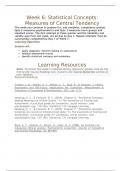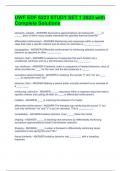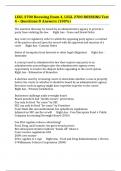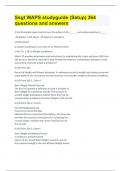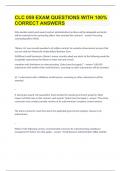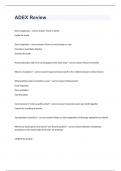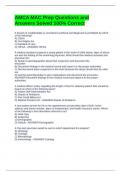Management practice (regarded as unhelpful):
- Power inequalities
- The agenda (focussing only on that issues that are important to managers)
- Multiple stakeholders
- Fashion victims (pursue the latest in thinking)
OB is not interdisciplinary; more multidisciplinary > a hodgepodge of various subjects.
Social arrangements → collective goals → collective performance (allocation of functions > division labour).
Social arrangements and collective goals are not very distinctive. Collective performance leads to authority
relationships and programme activities.
Organizations vs social arrangements: need for control, preoccupation with performance.
Organizational dilemma (p.13): how to reconcile inconsistency between individual needs and aspirations on
one hand and the collective purpose of the organization on the other → need to meet the needs of the people
that work for an organization too. Conflict: individual needs ↔ collective purpose.
Hierarchy of authority is one of the main mechanisms of organizational control.
Efficiency drive vs desire for freedom of expression, autonomy, creativity, self-development.
PESTLE: The political, economic, social, technological, legal and ecological context > sort of issues affecting the
organization and members.
Individual, group, structural, management process factors → organizational effectiveness, quality of working life.
Past events shape current perceptions and actions. Location in time.
Fundamental attribution error: Blame the individual tendency to emphasize explanations of the behaviour of
others on their personality and overlook the wider contextual influences.
Explanations for unhelpful behaviour:
*PESTLE > economic, social issues.
*Individual factors > personality, motivation.
*Group factors > employees don’t form a cohesive team.
*Structural factors > decision-making, hierarchy.
*Management process factors > inappropriate leadership, organizational changes.
More factors can cause a particular behaviour.
Stakeholder: anyone with an interest, or stake, in an organization.
Organizational effectiveness: multidimensional concept defined differently by different stakeholders including
a range of quantitative and qualitative measures.
Balanced scorecard?: an approach to defining organizational effectiveness using a combination of quantitative
and qualitative measures to assess performance. E.g. stakeholder value, employ-development, working condit.
Quality of working life: linked to organizational effectiveness > Individual’s overall assessment of satisfaction
with their job, working condition’s pay, training etc.
‘Outputs’ overlap ‘inputs’: high motivation + group cohesiveness > organizational effectiveness.
Good performance > higher motivation + teamwork.
Science goals:
1. Description: observation, asking questions, studying documents.
2. Explanation
3. Prediction: sometimes we can explain but not predict. More interested in probabilities and groups.
Some disastrous predictions: to trigger action, prevent prophecies from coming true.
4. Control: the ability to change things – you first need an understanding of how things currently work.
Natural science: describes objective reality > stable.
Social science: describing the ways in which people understand and interpret their circumstances (change).
,We cannot manipulate people but maybe control aspects of employee behaviour.
E.g. staff training and development programmes > employee knowledge/skills.
E.g. job redesign > employee motivation, commitment and performance.
Positivist approach: objective using observations/experiments. Measurable variables.
Dependent variable: effect of a cause. Cause: independent.
Operational definition: method to measure the incidence of a variable in practice.
Variance theory: an approach to explaining OB based on universal relationships between dependent and
independent variables. Offers definitive explanations in which causes and outcomes are related in unchanging
ways (e.g. temperature?).
Constructivism: many aspects of the objective reality are defined by us (interpretations, meanings). We are
self-interpreting beings > attach meaning and purpose to what we do.
Process theory: outcomes are often generated by combination of factors interacting with each other over time.
It helps us understand complex phenomena that are influenced by a number of factors which are difficult to
measure. Probabilistic explanations.
Positivism: search for consistent links and improves effectiveness and adaptability.
Constructivism: explanations may apply to a small part of the social and organizational world – change with
time. New ideas by self-critical awareness.
Managers especially use prediction and control and less explanation and description (needs evidence,
experience, and judgment?). SEE P.26 FOR TABLE ON POSITIVISM AND CONSTRUCTIVISM.
Evidence-based management: more initiatives/solutions implemented.
It means systematically using the best available research evidence to inform decisions about how to manage
people and organizations. 1. Understand problem and 2. Develop solutions.
Human resource management: develops and implements policies > quality of working life and encourage
commitment. It means a function responsible for establishing integrated personnel policies to support
organization strategy. HRM policies: independent. Quality working life/effectiveness organization: dependent.
Employment cycle: sequence of stages through which all employees pass in each working position they hold.
BATH MODEL HRM:
HR policy areas → AMO (Ability, motivation, opportunity) factors (for people to perform beyond the minimal
requirements of a job) → implementation → response commitment+ satisfaction → behaviour → performance.
Discretionary behaviour: Freedom to decide how work is going to be performed. Positive when putting in extra
effort. Negative when withholding info/cooperation.
Encouragement: process theory, by means of:
1. Basic HR policies > AMO 2. Trust, respect, encouragement by managers 3. Job satisfaction+commitment
4. Positive discretionary behaviour
And by implementing:
Communication, career opportunities, team working, job security, pay etc.
Hard HR: to control/reduce costs. Soft HR: maintain motivation and commitment.
SUMMARY PAGE 34
, CHAPTER 2 ENVIRONMENT
Environment: issues trends, events outside the boundaries of the organization, which influence internal
decisions/behaviours.
Stakeholder: anyone concerned with how an organization operates and who’ll be affected by its
decisions/actions.
External environment factors, trends, developments → lead to change in → internal organization structures
processes, behaviours.
Environmental uncertainty: degree of unpredictable turbulence and change in the PESTLE context in which an
organization operates. Lack of clear view of the way ahead.
The internal structures/processes of an organization should reflect or ‘fit’ with the external environment.
Environmental uncertainty:
1. Simplicity-complexity dimension: refers to issues e.g. number of different issues faced, number of
things to worry about. More factors > more complexity.
2. Stability-dynamism dimension: issues stable or changing and subject to slow movement or to abrupt
shifts.
Duncan’s typology:
Environmental complexity: lots of variables to consider.
Environmental dynamism: due to the changes you don’t know what’s going to happen.
External environments do not determine internal structures and processes > management perceptions affect
decisions and managers differ.
Ansoff:
→Environment is repetitive, no change (based on the past) → strategy should be stable and based on
precedent → management should seek stability, reject change.
→Surprising environment, unpredictable change → novel strategies should be based on creativity →
management should embrace change, seek novelty.
Extrapolative (future can be predicted) change: Ansoff therefore thinks that managers lack skills.
Discontinuous (ability to predict is limited) change: requires creativity, anticipating change.
Stimulus: external environmental pressures >> Response: internal organizational characteristics.
Four flaws in the stimulus → response:
1. Environmental determinism: not guaranteed the expected response. Argument that internal
organizational responses are primarily determined by external environmental factors.
2. We cannot clearly say what is ‘out there’ and ‘in here’. Employees → member of a whole society > values
and preferences are ‘inside’ the organization.
3. An organization chooses and influences its environment strategic choice > ability to decide on the
environment. E.g. where to manufacture cars, which country.
4. Continuity: model presents a rapid change, but this is not the case.
Environmental scanning: techniques for identifying/predicting the impact of external trends/developments of
the internal functioning of an organization. Three major trends affecting organizations:
1. Technology: increasing number of knowledge workers. Influence design/nature products and services.
2. Globalization: shifting economies to lower labour costs. Intensification of world-wide social and business
relationships which link localities > local conditions shaped.
- Death of distance: geographical separation of countries/individuals is unimportant.
- Price movements in exchanges across the world.
3. Demographics: - ageing population (Baby Boomers>Silver tsunami) >> solutions on p.53
- younger generation
Both generations are more interested in challenge, recognition than in reward.


